First use
This video shows you how to get to grips with the screen's functions, navigate between the different riding modes and connect to the eBike Connect application.
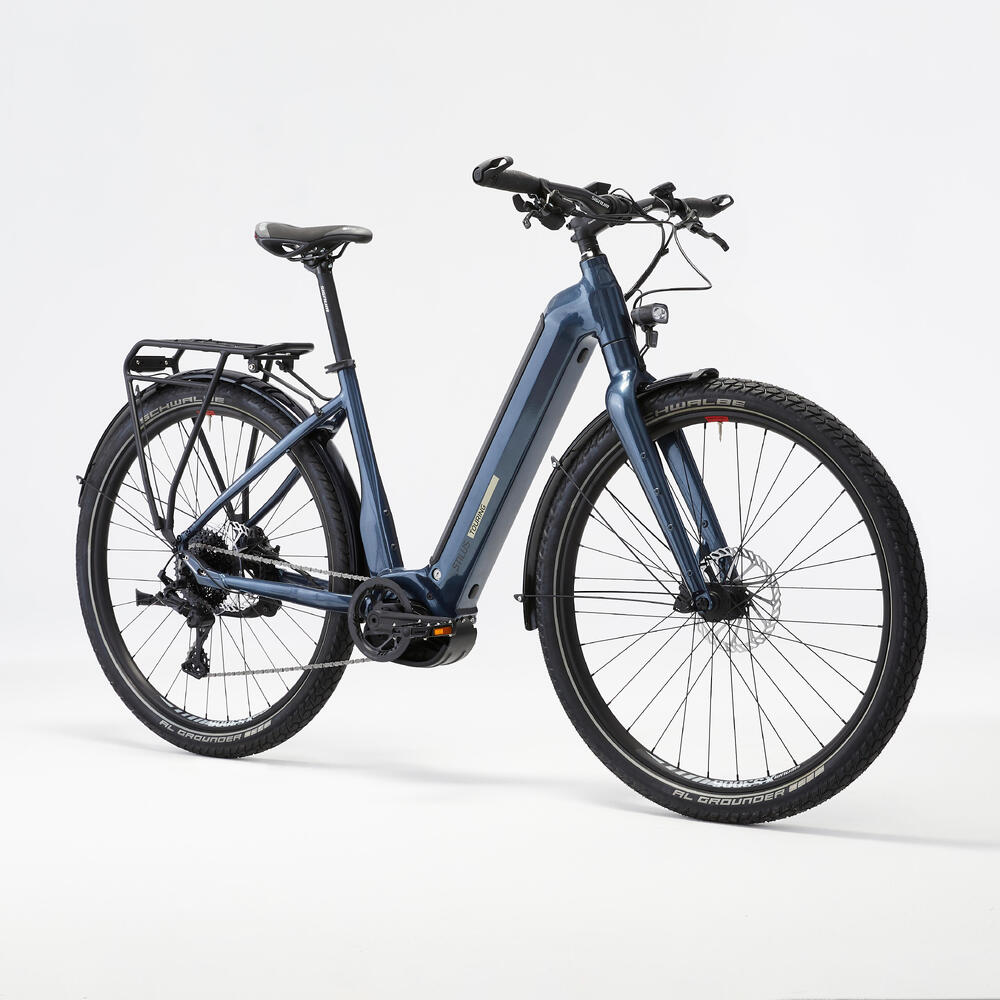
REF: 8823135
2023
Need help with assembling, maintaining, repairing or finding an accessory for your bike?
Here you will find tutorials and videos that will show you how step by step.
You can also download the CE declaration of conformity for your bike.

Battery instructions

Motor instructions

Screen instructions

Certificate of compliance
This video shows you how to get to grips with the screen's functions, navigate between the different riding modes and connect to the eBike Connect application.
Remember to check the condition of your bike before each ride.
Your bike is equipped with a wheel with a quick-release mechanism. Please watch the first part of the video for instructions.
WARNING: if your rear wheel is loose, come and see us in the workshop!
Check that your brakes are working correctly. If you feel that they aren't powerful enough, try adjusting them with the help of our video tutorial.
If you're still having problems, come and see us in one of our workshops!
When you first get your bike from the store, the brake pads and discs are brand new and therefore the initial braking performance is very low (weak).
A sharp, prolonged braking action (for example, during a descent) with brakes that have never before been used can cause the pads to overheat and to "glaze over".
To prevent this from happening (which could make them unusable), we recommend that you bed them in. This takes about 10 braking actions per brake. For each braking action: apply a single brake to slow the bike down from about 25 km/h to 5 km/h without fully blocking the wheel. Repeat with the other brake.
RIVERSIDE 100e
The tyre pressure is something you should check regularly on an electric bike. The wheels have a lot of weight on them because of the combination of the motor and bike.
To reduce the risk of punctures and ensure your bike can achieve its maximum range, we recommend inflating your tyres to a pressure of 2 to 3 bars. We've chosen a bike with no suspension to allow you to take your luggage with you. So for greater comfort, we advise you to choose a low pressure.
Check that your different cable housings aren't damaged and that they're well-positioned.
If you see a damaged housing (for example, if you see the metal cable), change it as soon as possible.
Visit a workshop so that our mechanics can repair your bike!
Adjusting your saddle to the correct height will prevent pain.
We recommend wearing a helmet and gloves while riding. Because anyone can take a tumble...

Make sure your battery is locked in place and that you have enough charge for your journey.
Don't ride your bike with the battery's key in its lock.
SETTING OUT ON A CASUAL RIDE OR LONGER TOUR ON YOUR RIVERSIDE BIKE?
Here are a few tips for you:
1- SAFETY
Wear a certified helmet, purchased recently; remember that the head is impacted in one out of every two falls!!
IMPORTANT: Helmets have a limited effective lifespan, even if they haven't been involved in a crash! Find out more when making your purchase.
- Set off with a bike that is properly adjusted and well maintained.
- Take your phone (fully charged!) to make a call should you need help.
- Map out your route ahead of time so you can take bike trails and paths that are free of cars as much as possible.
- Take a first aid kit (in a bag under the saddle, for example)
- If you'll be riding in the dark, make sure you have front and back lights mounted and operational.
2- COMFORT
- If you're just getting started with cycling: Start with one-hour rides and gradually lengthen them as you gain experience.
- Wear clothing that is appropriate for the length of your ride, plus gloves.
- Don't try to push hard on the pedals. Instead, switch gears so you can pedal more easily and faster. You'll be able to go further for longer.
- Depending on the weather, bring along clothing to protect you from the cold or rain.
- Don't forget to do some stretches after your ride.
- STAY HYDRATED!!
3- ALWAYS TAKE A TYRE REPAIR KIT WITH YOU!
- A tyre pump. Some pumps will fit onto the frame's bottle cage bolts.
- 3 tyre levers, one inner tube, a Riverside 100 15 mm spanner, which you can fit into a saddle bag.
4- DRINK REGULARLY
- Attach a bottle cage to your bike so you can drink as you ride, or carry a water bottle in a backpack.
- Remember to drink water regularly (every 20 minutes and at least half a litre per hour).
5- REMEMBER TO EAT
- Take some energy bars with you (you can carry them in a saddle bag or handlebar bag)
- Don't wait until you feel hungry to eat. Eat every hour to fuel your muscles.
It takes 6 hours to charge the battery fully (from 0% to 100%). However, it only takes 2 1/2 hours to charge the battery from 0% to 50%.
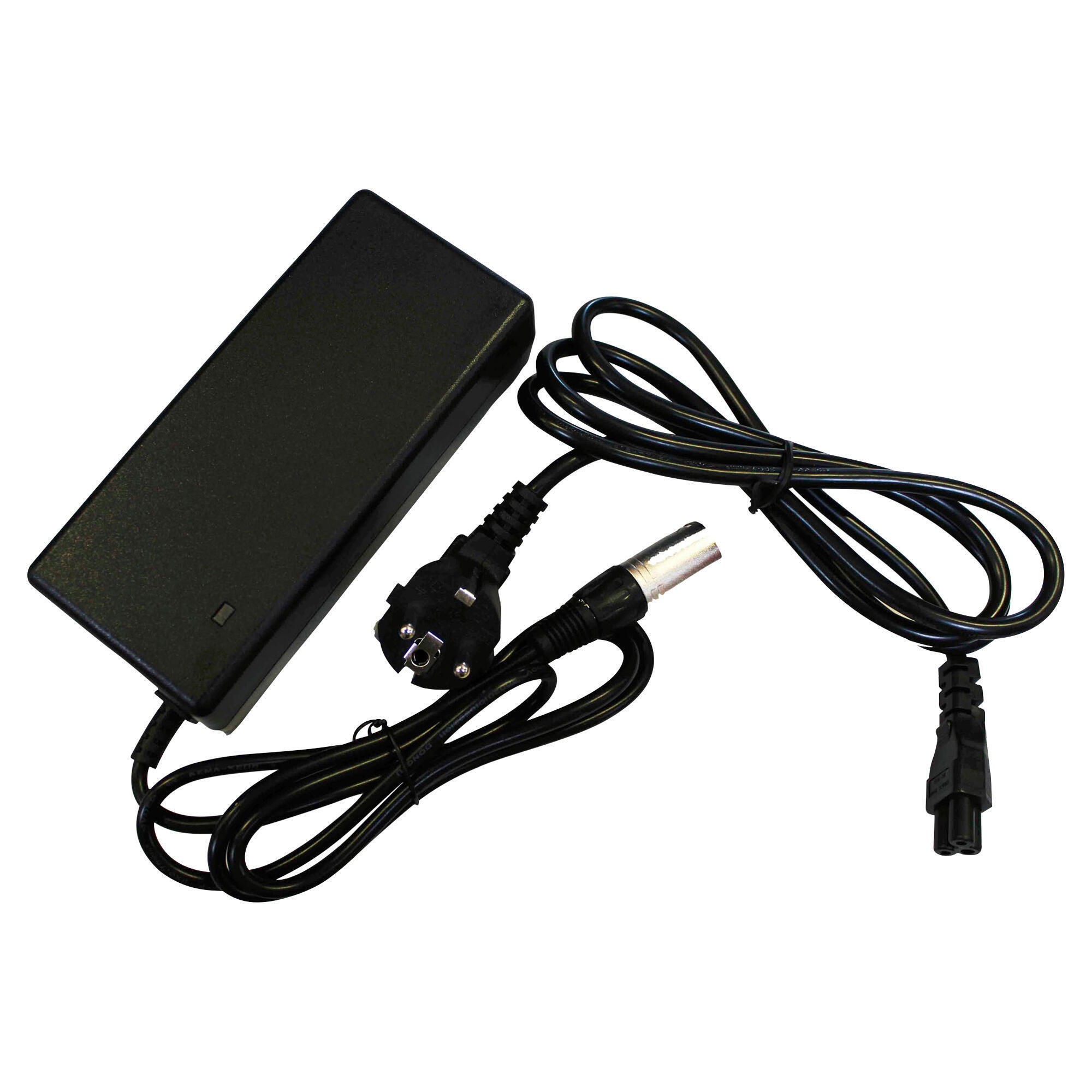
It's an electrical assistance bike. That means it's entirely possible to ride without this assistance.
However, you may well notice the additional weight of the assistance system.
Yes, the charger and the battery are designed to be plugged in 24 hours a day.
When the battery is fully charged, the charger stops charging.
No. Lithium-ion batteries have no memory effect. So they can be charged at any time.
To make your battery last longer, it is recommended that you don't let it drop below 20% charged.
When your battery wears out, take it to your local Decathlon store, which will send it to a specialist facility to be recycled.
Lithium batteries have a long life and in the event of a problem, the Bosch guarantee applies.
It is essential to store and charge your battery at room temperature (20°C), in a dry place away from direct sunlight.
To avoid deep discharge, which may cause it to malfunction, do not put the battery away when less than 20% charged.
If you aren't using your battery for more than 3 months, it should be charged between 50 and 60% when you put it away.
Remember to recharge the battery at least every 6 months, even when not in use, to prevent deep discharge which can diminish the battery’s capacity.
You can get a new battery: Power Tube 750.
You can store your battery for up to six months without recharging, without degrading battery capacity. If storing it for longer than six months, you must first charge it to between 50 and 60%.
On their website, Bosch have set up an app to calculate your battery's range based on how you use it.
If you're not sure you have enough battery life for your ride, you could use this simulator by indicating your use of the power modes, your total load weight, pedalling cadence, the components on your Stilus E Touring and by entering information about the terrain.
The Bosch charger supplied with the bike is already the fastest charger.
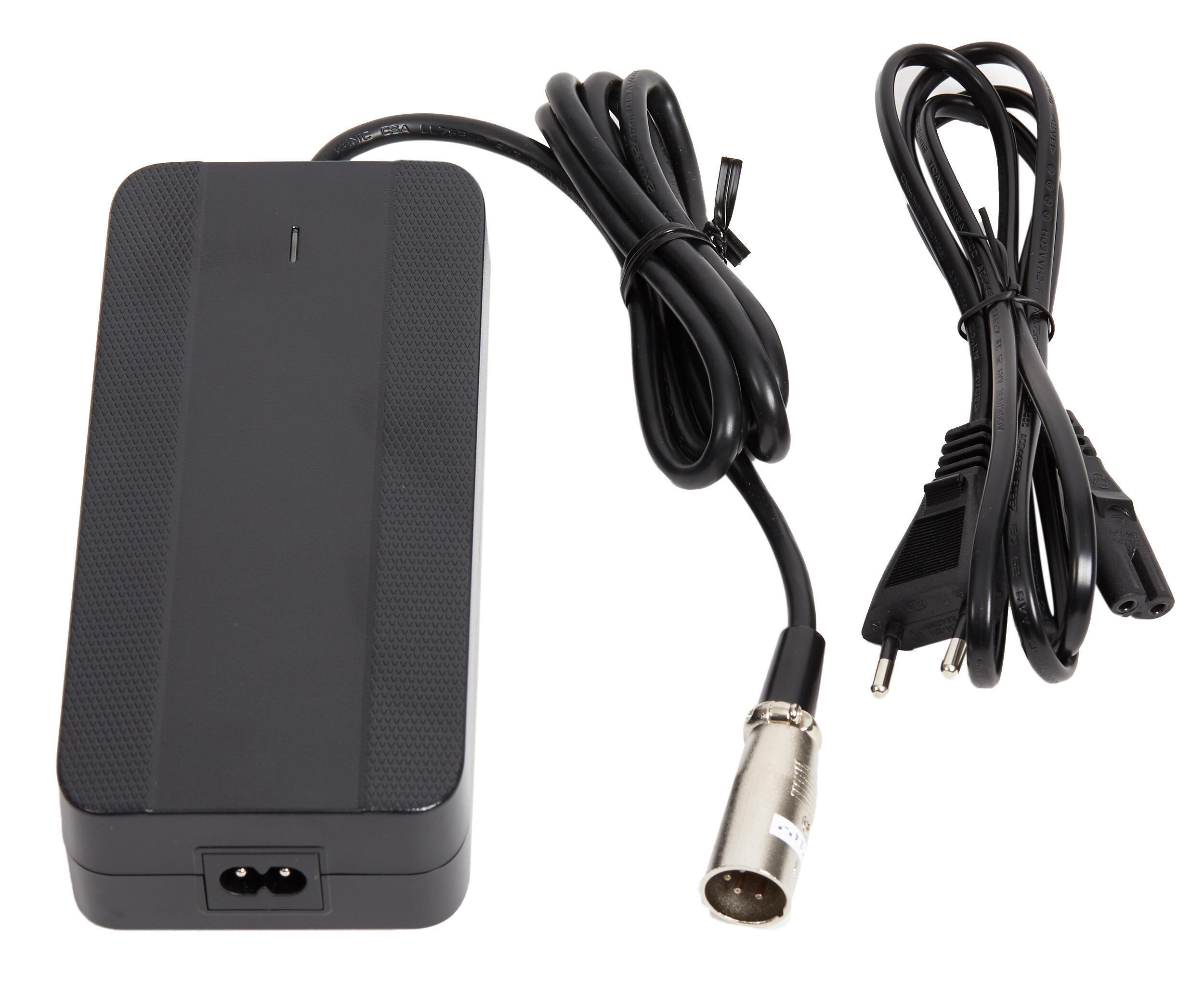
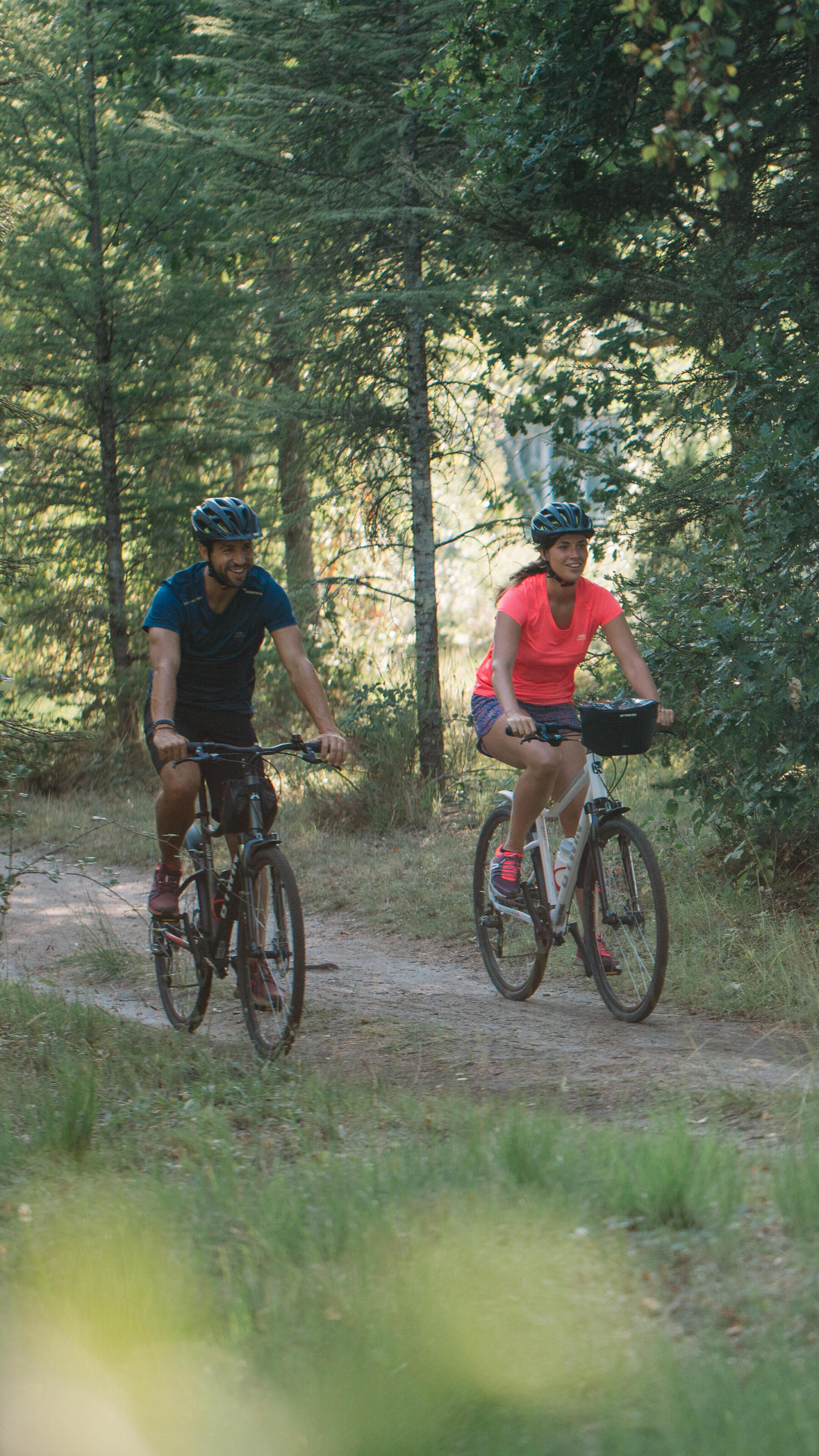
1. Make sure you follow the recommendations for using and storing your battery.
Your electric bike's range depends on a number of factors:
> THE BIKE'S LOAD: The range will be reduced if the bike is carrying too much weight.
> THE ROUTE: The range is reduced on climbs.
> THE OUTSIDE TEMPERATURE: The range is reduced in colder weather (by up to 50%).
> THE POWER ASSIST MODE: We recommend reducing the assistance mode when the battery is running low.
> FOLLOWING THE INSTRUCTIONS FOR CHARGING AND STORING YOUR BATTERY.
2. An old battery can have reduced performance.
As they age, batteries lose some of their range. Visit your Decathlon workshop to give your battery a check-up.

TRAILERS

Child seats

Front pannier rack
When you take your new bike out for a ride for the first time, a lot of parts can shift and fall into place.
You'll hear the spokes on your wheels creak because of the residual torsion in them from the assembly process; this is normal.
Your wheels should not buckle or be twisted in any way. If this does happen, use the free check-up available to you within 3 months of purchase and call in at one of our Decathlon workshops to have your wheel repaired free of charge.
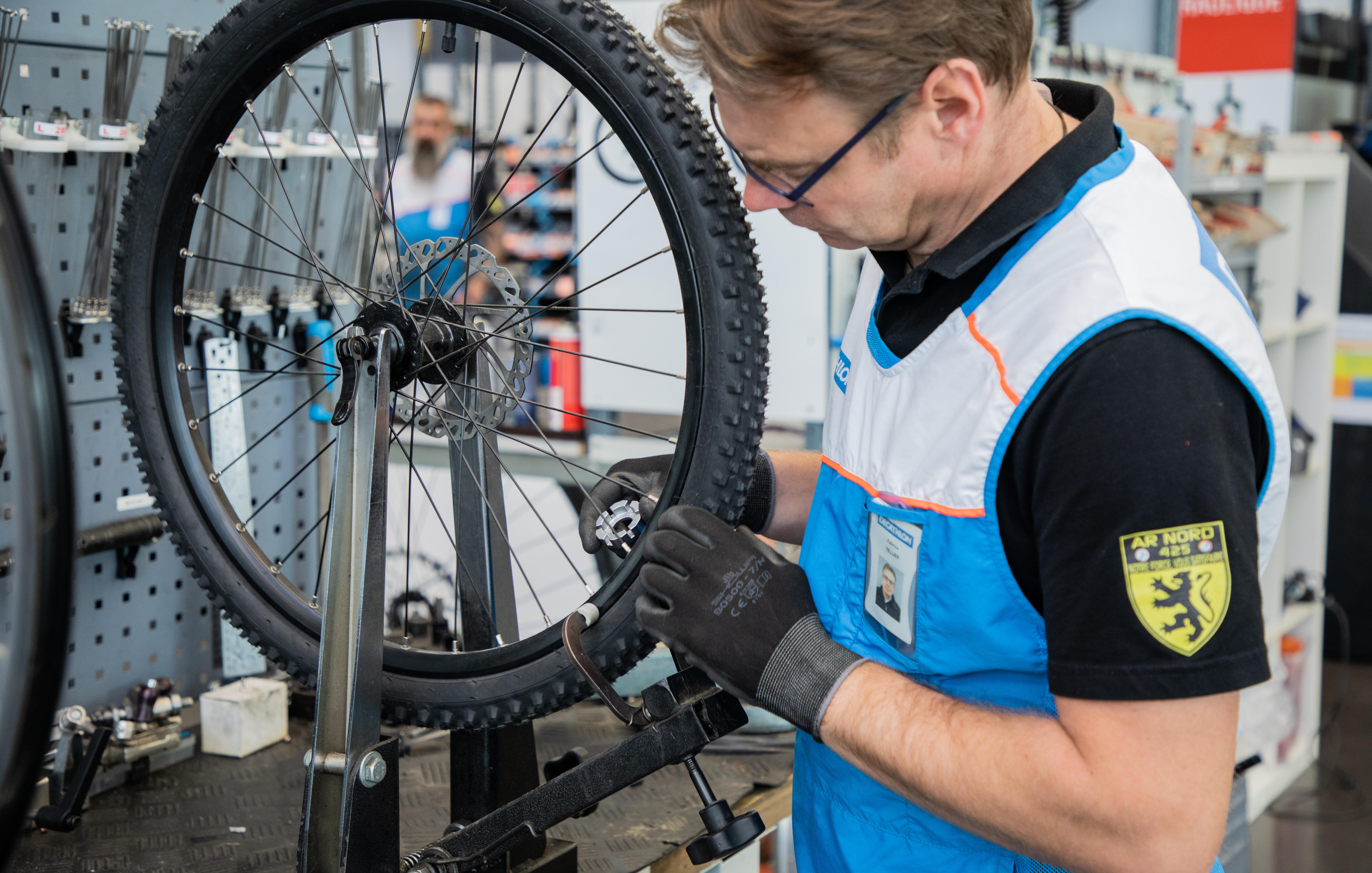
There could be several reasons why your gears (cogs) are not shifting correctly.
1. Check the position of the cable housing end caps (tips). Incorrectly positioned cable housing caps can hinder the pulling action on the derailleur cable and cause the shifting of the gears to be off. If a housing end is out of position, push it back into place.
2. The cable and housing might be jammed. If you can't shift into the smallest gears (onto the smallest cogs), and if the derailleur doesn't move even when the gear shifter is operated, then the cable and the housing have probably jammed up. In this case, the cable and housing need to be replaced.
3. Take your Riverside to a Decathlon workshop to have your derailleur adjusted.
4. Also check that the derailleur hanger is not bent. If it is, check the "DERAILLEUR HANGER IS BROKEN" section.
NB: If you regularly ride your Riverside in wet or muddy conditions, or if you regularly wash your Riverside bike with a lot of water, then your cables and cable housing will need to be replaced more frequently. Washing your bike using a pressure hose is highly discouraged as it can push dirt and dust into the cable housing.
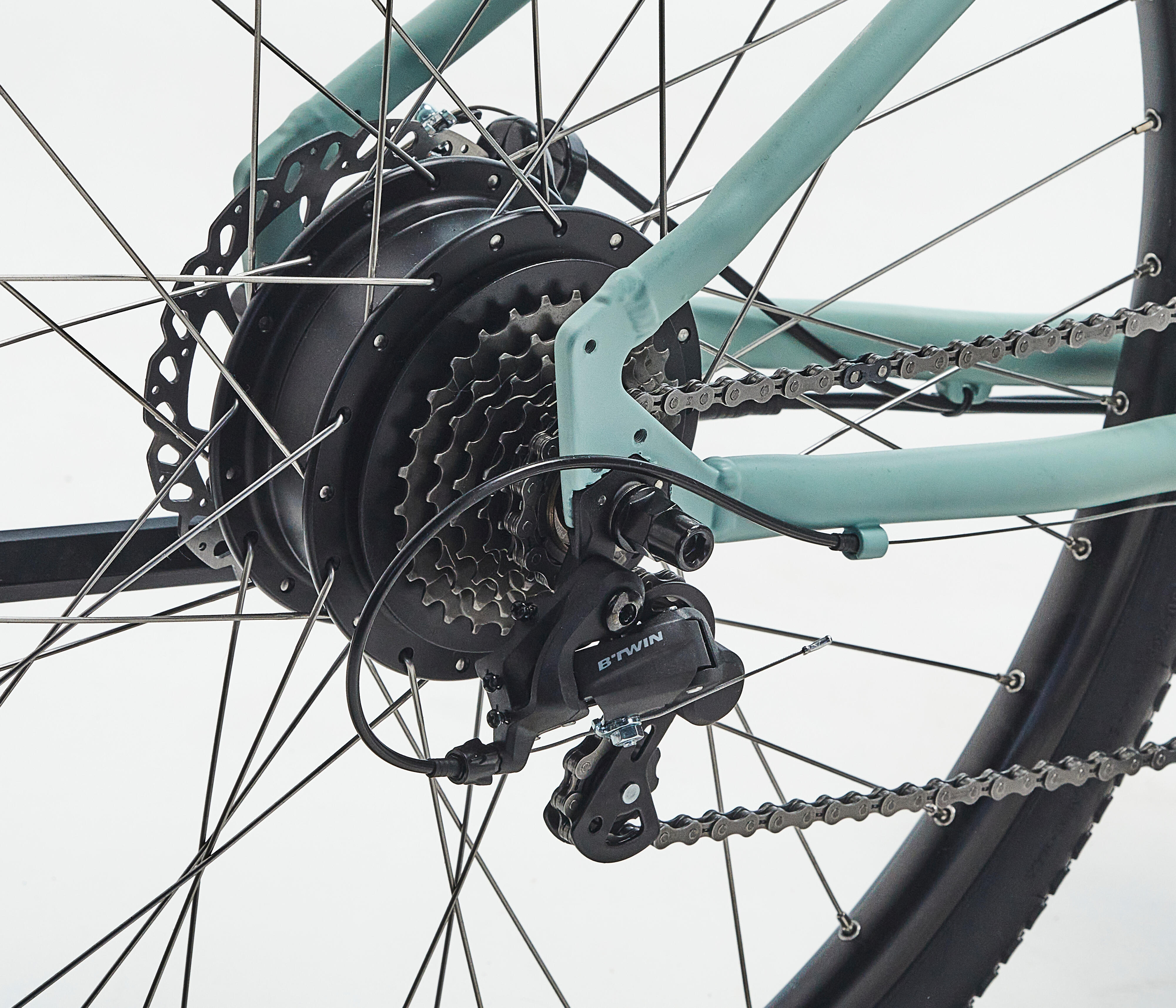
Before putting on a new inner tube, have a quick feel inside the tyre to make sure there's nothing sharp still stuck to the inside.
If you lose the key to your battery, you need to have a new lock made at Abus with new keys, which costs between £12 and £15.

1. CHECK THE BATTERY > CHARGER > MAINS SOCKET CONNECTION
Make sure the charger you are using is an original one provided by Bosch.
Plug the charger into the battery and into a mains socket.
The LEDs are off = the battery is discharged.
The LEDs charge progressively (each LED corresponds to 20% charge) = the battery is charging
All the LEDs are lit = the battery has finished charging.
A completely drained battery will take 6 hours to charge fully.
2. CHECK THAT THERE IS NO DIRT PREVENTING CHARGING
The charger's and the battery's connectors should be clean. There should be no dirt preventing contact between the battery and its charger.
3. THE LED INDICATORS ON THE BATTERY MAY BE FAULTY
Visit your Decathlon workshop to have them repaired.
The five LEDs on the charge status indicator (6) show the battery charge level when the battery is switched on.
Each LED represents 20% of a full battery charge. When the battery is fully charged, all five LEDs are lit.
The battery charge level is also displayed on the onboard computer screen when the battery is on. Read and follow the operating instructions for the control unit and on-board computer.
When the battery charge level is below 5%, all the LEDs on the charge status indicator (6) are unlit, but there is still a display function on the on-board computer.
When charging is complete, disconnect the battery from the charger and the charger from the mains.
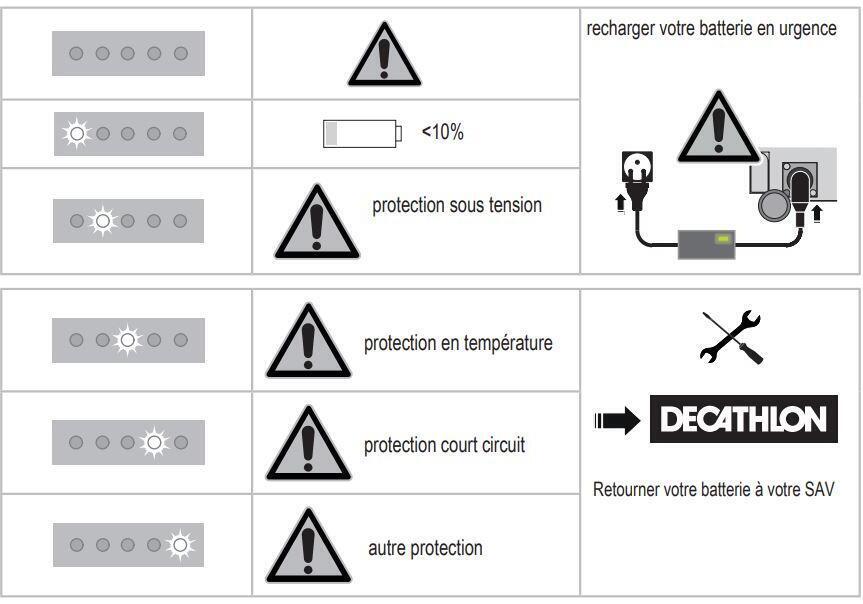
1- CHECK THAT THE BATTERY IS CHARGED
If the battery is almost empty and the bike is set to a high assistance mode, this can cause the bike to judder before the battery goes completely flat.
> Remove the battery from the bike.
> Press the battery button.
> Check that at least one LED lights up.
> If none of the LEDs light up, or the last LED flashes, charge the battery.
2- CHECK THAT THE BATTERY IS CLEAN, PROPERLY ATTACHED, AND LOCKED IN PLACE
> Check that the battery connectors and housing are clean and in good condition.
> The battery should be correctly inserted into its slot. (Remember to put the lock into the open position)
3- CHECK THAT THE MOTOR CONNECTOR IS PLUGGED IN CORRECTLY
> The motor plug, which is located on the frame's back left stay, may be slightly out of place.
Simply push it in so that it is fully in place (the male connector shouldn't be poking out at all). This should stop the engine noise and juddering.
If the problem persists, please contact us through the contact form, or visit a Decathlon workshop.
1- CHECK THAT THE SCREEN IS PROPERLY PLUGGED IN
> Check the screen's connector, which can be found on the front of the handlebar.
> Loosen the two knobs and pull to disconnect the console from the connector cable.
> Check that none of the plugs are bent.
> Reconnect it, taking care to orient the connectors correctly to avoid bending a plug! Use the two arrows etched into each side of the connectors to check the orientation. These two arrows must be lined up face to face before being plugged in.
2- CHECK THAT THE BATTERY IS PROPERLY CHARGED
If the battery is almost empty and the bike is set to a high assistance mode, this can make the bike judder, before the battery goes completely flat.
> Remove the battery from the bike.
> Press the battery button.
> Check that at least one LED lights up.
> If none of the LEDs light up, or the last LED flashes, charge the battery.
3- CHECK THAT THE BATTERY IS CLEAN, PROPERLY PLUGGED IN, AND LOCKED IN PLACE
> Check that the battery connectors and battery housing are clean.
> The battery must be correctly inserted into the lower slot and the handle must be fully down (you should hear it click to confirm that it's in correctly).
4- LET THE SYSTEM COOL DOWN
In high temperatures, or after a long ride, the electric system may overheat. Allow the bike to cool down by not using the electrical assistance for several minutes, then turn it back on.
If the problem persists, please contact us through the contact form, or visit a Decathlon workshop.
1- CHECK THE TYRE PRESSURE
> The tyre pressure determines how efficiently the electric assistance works. Before each ride, make sure your tyres are inflated to between 2 and 3 bars.
2- CHECK THAT THE BATTERY IS CHARGED
If the battery charge level is low, the motor won't receive enough power to deliver the desired assistance level. In this case, switch to a lower electrical assistance mode.
3- CHECK THAT THE BATTERY IS CORRECTLY PLUGGED IN
If the motor seems to judder, check that the connector to the motor is fully and securely plugged in.
The motor plug at the top of the frame's left rear stay could be disconnected or damaged.
Simply push it in so that it is fully in place (the male connector shouldn't be poking out at all). This should stop the engine noise and juddering.
4- BE CAREFUL NOT TO OVERLOAD THE BIKE
If the problem persists, please contact us via the contact form, or visit your local Decathlon workshop.

Servicing your Stilus E touring will keep all of its parts working for as long as possible and ensure you have the most fun when riding. Failing to maintain your bike can lead to problems such as jammed cables, rust, leaks, premature wear, and more.
Your bike's parts will also last longer, which means a lower environmental impact.
As soon as you start using the bike, some components will move slightly.
This is why we offer a free check for your bike 6 months after purchase.
It's a good idea to clean your bike thoroughly from time to time. The more frequently you ride, the more often this type of cleaning is recommended.
When cleaning your Stilus E Touring, leave the battery CONNECTED to the bike. This will help prevent water from getting into the electric controller.
Over the course of your bike's lifetime, as you put miles on it, you'll need to replace certain parts for safety reasons and to ensure everything works smoothly.
Every 100 km: Clean the chain and lubricate the drive train.
Every 1000 km: Check the brake pads and, if necessary, visit your local Decathlon workshop to have them replaced or do it yourself with the help of our tutorial.
Check your tyres or replace them by following our tutorial.
Every 5000 km: Have your chain and rear wheel cogs replaced (visit the nearest Decathlon workshop).
Keep the contacts clean at all times.Clean them with a dry brush and never with a metal object.
Clean the rest of the battery with a damp cloth, not with a hose, and above all do not immerse the battery.
How to degrease your bike chain
In order to properly degrease your chain, it's important to spray a degreasing product on the entire chain and drive train. Then, wipe the chain and the cassette with a clean cloth to remove grease and dirt. Depending on the general condition of your chain, be sure to clean any particularly dirty parts thoroughly!
Lastly, rinse it abundantly until you've removed all the residue. Sometimes, even after spraying with cleaning product, some dirt might still remain.
So finish by letting it sit for a few minutes before wiping your chain down again with a dry cloth to fully remove any remaining residue.
To perform this task more efficiently and for a cleaner chain, we recommend using our chain cleaner.
Note that the Stilus E Touring has a central motor and therefore a free crankset, so if you pedal backwards the chain won't move. To lubricate your drive train, you can hang your bike on a workshop stand or watch the tip mentioned in our video.

After replacing your brake pads, we recommend bedding them in so that they don't "seize up" (which would cause weaker braking power).
Your tyre might be quite rigid if it is old; it's okay to use some force to get it off.
Simply unscrew the cassette using the lockring tool and chain whip, then screw on the new cassette.
You'll find the lockring tool and chain whip at the link below; for a new cassette, please check the "Spare Parts" section.
To do this, you will need: a chain tool, a new chain, and a quick-link.
Place the chain on the last cog and on the smallest chainring.
Remove the quick-link using the pliers or chain tool, then take the old chain off the drive train.
Place the new chain on the last cog and on the smallest chainring. This will make it easier to determine its optimal length.
IMPORTANT: certain chains only fit in 1 direction, so be sure to check the user guide.
The chain should pass close to the top pulley of the upper jockey wheel on the derailleur.
Once you've determined the correct length, use the chain tool to cut the chain.
Lastly, install the quick-link onto the chain, turn the pedal so as to position the quick-link on the upper part of the chain, and use your hand to apply pressure and ensure it is firmly locked in place.
Need equipment to repair or maintain your bike? Here are the essentials.

BIKE CARE
PRODUCTS
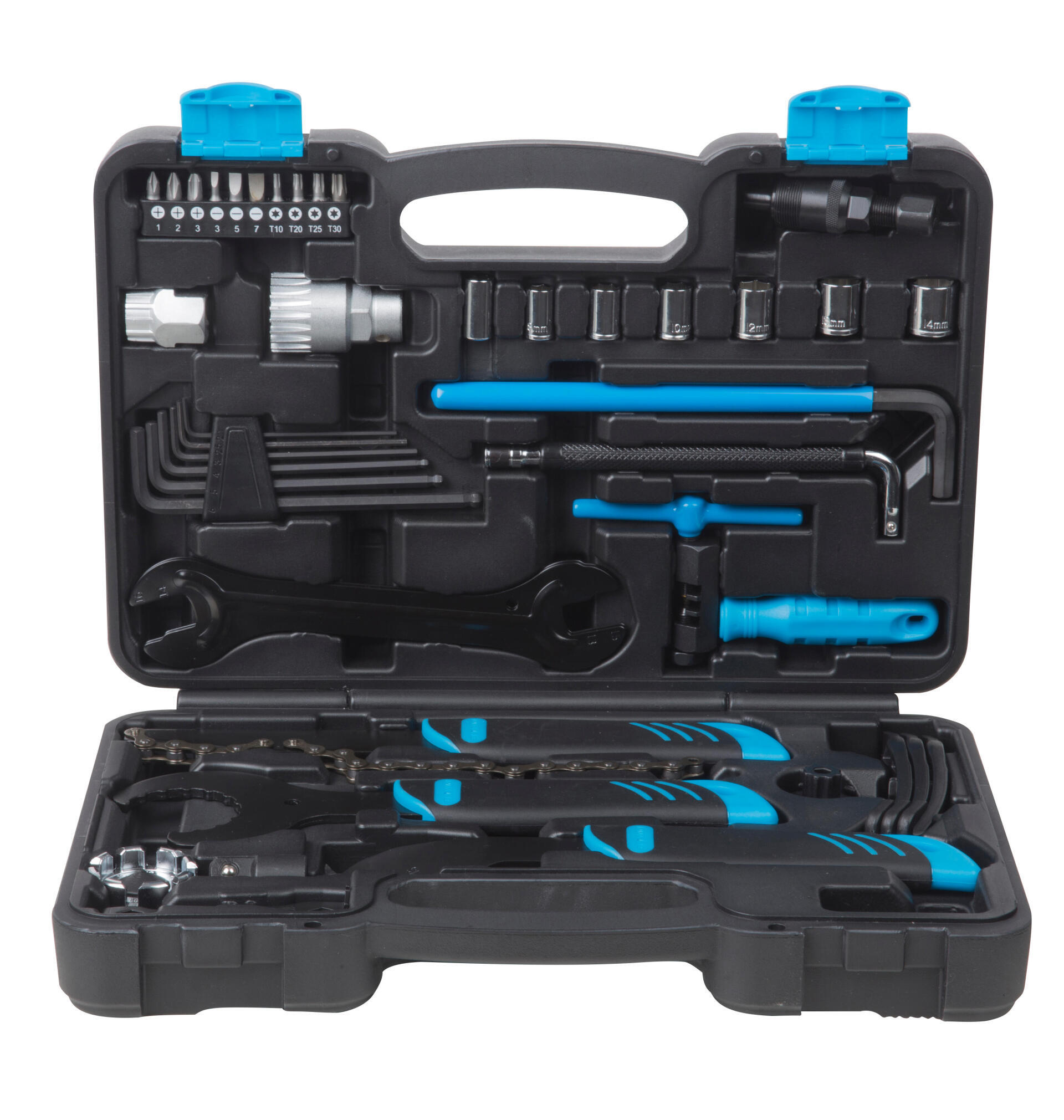
BIKE
TOOLS

WORKSTAND

MULTIFUNCTION
TOOLS

NEED SPARE PARTS FOR YOUR STILUS E TOURING?

Please contact one of our technicians who will be happy to help

Repair your bike in store or right at home! Our qualified mechanics would be happy to help with your bike.